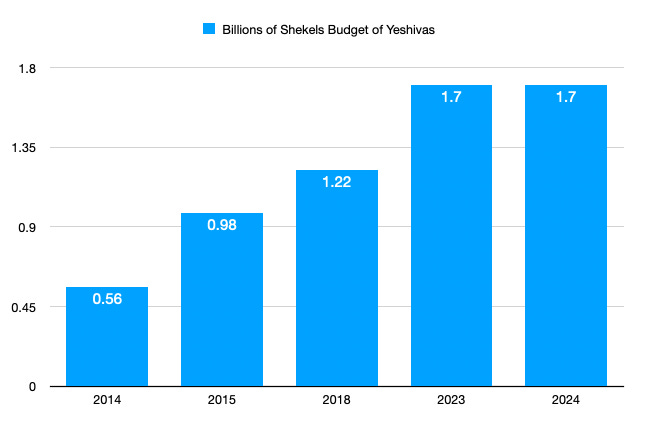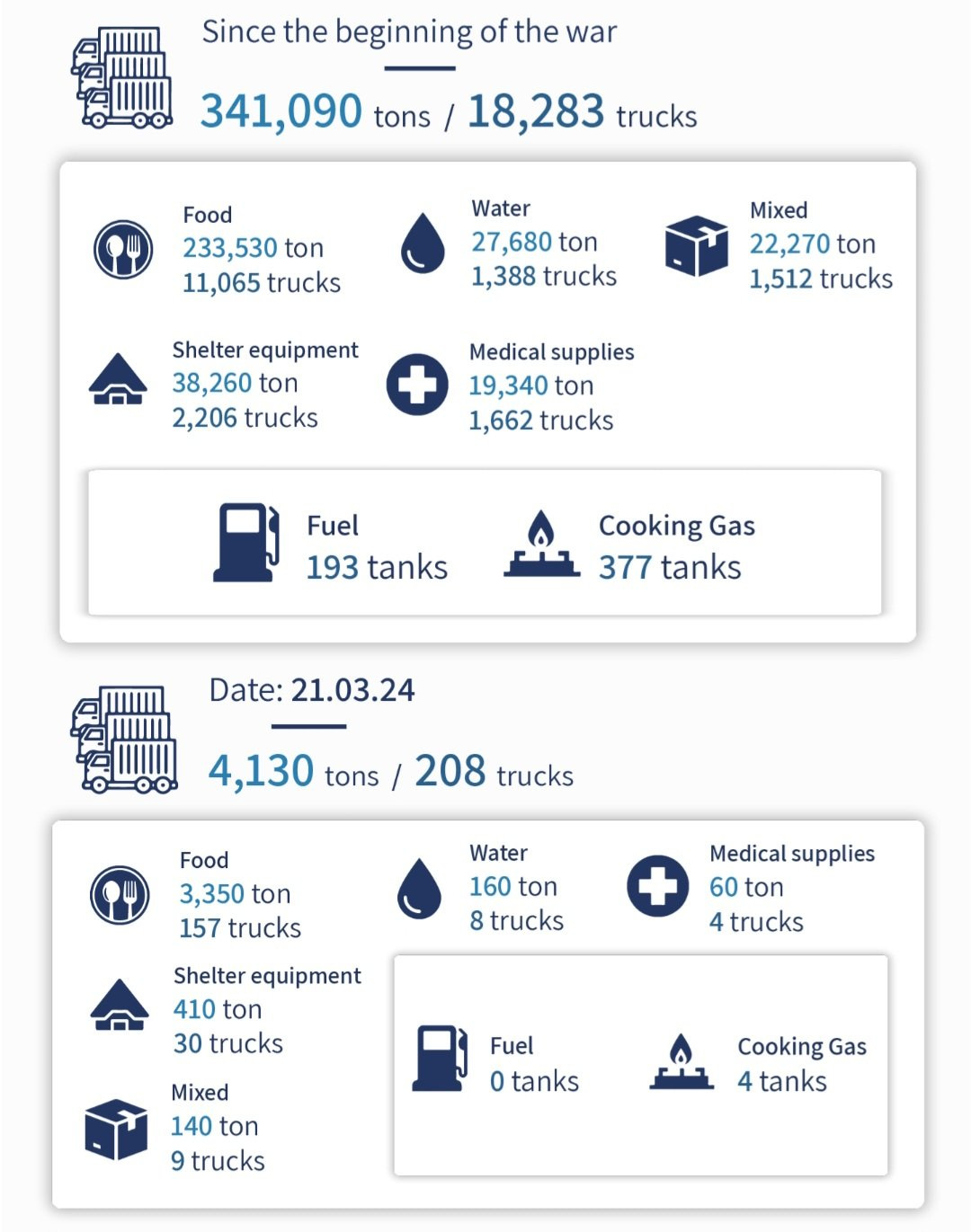DAY 170 OF THE GAZA WAR: IDF Expands Operation to Other Hospitals, Progress in Hostage Negotiations, Ultra Orthodox and the Draft
Tel Aviv Diary, March 24, 2024
IN GAZA
The action at the Shifa Hospital complex continues. To date, 1,000 individuals have been detained, of which 480 have been confirmed as terrorists affiliated with either Hamas or Islamic Jihad. Rumors persist about the capture of more high-ranking leaders. The IDF is still attempting to keep their names confidential. Regrettably, an additional soldier, Staff Sergeant Lior Raviv (21) was killed in the combat at Shifa.
The IDF expanded its operation in Khan Younis today, returning to the western portion of the city. Late this afternoon, the IDF announced it had surrounded both the El-Amal and Nasser hospitals, based on reliable intelligence that Hamas terrorists had returned to both these locations. The Army hopes to replicate its success at Shifa in these two hospitals. The outcomes of these operations will become apparent in the coming days.
IN THE NORTH
Last night, Israel launched its third attack on Balbak in the Beka Valley, situated deep in Lebanon, in response to the entry of two drones from Lebanon. In retaliation, Hezbollah fired 50 rockets at communities along the border today.
HOSTAGES
Israel has agreed to show greater flexibility in the ongoing negotiations and has accepted the American-proposed compromise. While Hamas initially demanded the release of 950 Palestinian prisoners, which Israel classifies as terrorists, in exchange for 40 hostages, Israel was prepared to release 400. The United States proposed a middle ground of 700 releases, which Israel accepted.
Furthermore, Israel agreed to the American proposal regarding the number of individuals implicated in serious offenses to be released. Israel has also indicated a willingness to discuss the return of male residents to Northern Gaza. There is cautious optimism in Israel that a deal could be reached soon, in the coming weeks. However, securing an agreement hinges on Hamas’s genuine interest in an agreement amidst mounting international pressure on Israel.
RAFAH AND THE AMERICAN GOVERNMENT
Today, Vice President Harris joined the chorus of American officials cautioning against Israel taking any actions in Rafah. These public statements are misguided, and frankly not very helpful. It's one thing to express concerns or make threats in private discussions. However, it’s important to acknowledge that Israel is currently nowhere near ready to attack Rafah. Any potential actions to relocate the population would not be considered until after Ramadan— and even then, a Rafah operation would necessitate substantial preparation and reserve mobilization before Israel could take any action.
However, that's not the main issue with American criticism of Israel regarding Rafah. The US government prioritizes the release of hostages. By applying public pressure on Israel, they are also signaling to Hamas that Israel will not likely attack Rafah. This could inadvertently communicate to Hamas that there's no urgency to reach a deal, as one of Hamas’s main motivations for negotiating is to avoid an attack on Rafah. The outcome could be that Hamas might decide it's in no rush to reach any agreement.
A WORTHWHILE READ
Today, David Brooks published an excellent article titled: What Would You Have Israel Do to Defend Itself?
ULTRA-ORTHODOX MILITARY DRAFT
The major non-war news in Israel today centered once again on the issue of drafting the ultra-Orthodox. The government faces a deadline this week to justify to the Supreme Court why all ultra-Orthodox males should not be drafted immediately, given the law providing an exemption has expired. Moreover, the Army requires additional manpower. Plans are underway to pass a new law exempting the ultra-Orthodox from military service until the age 35, without imposing any penalties on the Yeshivas whose students do not enlist.
The professionals of the Ministry of Finance have released a warning about the financial implications of the proposed ultra-Orthodox draft exemption law. They estimate that the law could cost NIS 104 billion over the next decade and necessitate a 16% increase in taxes by 2065. Additionally, it could lead to 150,000 ultra-Orthodox individuals not entering the workforce.
Both Defense Minister Gallant and former Defense Minister Gantz both expressed staunch opposition to the law. Gantz even stated he would leave the government if the proposed law passes. It will take some time before such a law actually passes the Knesset. The primary purpose of proposing the new exemption law is less about its enactment and more as a bluffing tactic to persuade the Supreme Court to refrain from cutting off funding to the Yeshivas.
To provide some context and perspective, here is an overview of the funding allocated to Yeshivot and the number of ultra-Orthodox drafted in recent years:
TRUTH IN NUMBERS
One of the reasons we have been losing the information war is the blind acceptance of data disseminated by Hamas as factual by the media and the international community. Hamas controls the Health Ministry, which releases casualty figures, and the UN personnel in Gaza, responsible for reports on hunger, starvation, etc., is staffed by people associated with Hamas. Yet, the international press and foreign governments seem to accept all of these reports as if they had all been conducted by independent observers.
Over the last week, I have repeatedly stated that while some Gazans may not get as much food as they would like, or perhaps need, there is no starvation in Gaza. Moreover, despite claims to the contrary, there is no famine in Gaza; enough food has been entering on a consistent basis. Over the course of the last few days we have heard ridiculous warnings about potential starvation in Gaza by May, which seem unfounded — as if no improvements will be achieved between now and May. Currently, 22 operating bakeries in Gaza are producing over 2 million rolls and pitas each day.
Here is a the number of the trucks that have entered Gaza:
The discourse, of course, extends beyond just starvation, encompassing a broad range of misinformation. Surprisingly, the reported numbers of civilian and children's deaths have gone largely unchallenged.
Here’s the insight data scientist Mark Zlochin provides into the issue:
Remember those "reliable media sources" that account for an increasingly large percentage of alleged fatalities in Gaza? Today I encountered an interesting piece of data that allows to take a closer look at those "sources".
On March 4, Gazan "Government Media Office" (GMO) claimed the following:
"Since the beginning of the war, 30,534 "martyrs" have been brought to the hospitals.” https://t.me/mediagovps/2461
On the same day, Gazan Ministry of Health published a detailed report that included the same total number of fatalities - 30,534 - but also said the following: "...17,348 of them were registered martyrs, while more than 13,186 were monitored according to reliable media sources due to the interruption of communication with hospitals in Gaza [Governate] and the North”. https://t.me/MOHMediaGaza/5122
In other words, allegedly all 30,534 reported dead were brought to the hospitals, but only about 57% of them were registered in official hospital records, while the information about the remaining 43% was transferred to GMO and MoH via those unspecified "reliable media sources".
So, first of all, "Gazan authorities" expect us to believe that the hospitals have no problem to send the information to "reliable media sources", but for some reason cannot transfer it directly to MoH.
But it gets even more interesting, if we look at the claimed number of women and children.
GMO claims that the fatalities include "more than 13,430 children and 8,900 women", i.e. that women and children allegedly account for 73% of all fatalities.
MoH doesn't make any claims about the totals, but does provide a detailed demographic breakdown for the official hospital records:
Men - 7255 (41.8%)
Women - 5085 (29.3%)
Children - 5008 (28.9%)
Now, compare this to the percentages claimed by the GMO:
Men – 26.9%
Women – 29.1%
Children – 44.0%
As you can see, the percentage of women is virtually the same, but the percentage of men in GMO report dropped from 41.8% to 26.9, while for children the numbers jumped from 28.9% to 44%.
Quite incredible – the miracles that can be achieved when you use "reliable media sources", right?
Now, let's take a closer look, in order to better understand how this "statistical miracle" was manufactured.
If we subtract the hospital records numbers from the totals claimed by GMO, we get the following breakdown for "reliable media sources":
Men – 949 (7.2%)
Women – 3815 (28.9%)
Children – 8422 (63.9%)
Yup, this definitely looks very "reliable".
I wonder what the "fact-checkers" from BBC Verify that recently quoted GMO's claims as "facts" think about all this.
He went on to say:
I seem to have missed the MoH report that was published a week ago, on March 12 — so here is quick demographic breakdown of the most recent hospital fatalities records:
• 149 deaths registered between March 3 and March 12
• 115 (77.2%) males, 34 (22.8%) females
• 91 (61.1%) men, 30 (20.1%) women, 28 (18.8) children
A couple of important observations:
1) Given that the male/female ratio in Gaza is about 1.03, this means that about 54% of all those hospital records are excess male fatalities, which gives us a good proxy for the percentage of combatants
2) 24 out of 28 children are boys, so it is likely that about 20 of them (13.4% of all death records) are 16-17-year old child soldiers
HOUTHIS
Here is the release of the CENTCOM regarding the Houthis:
March 23, the Iranian-backed Houthis launched four anti-ship ballistic missiles (ASBM) into the Red Sea in the vicinity of M/V Huang Pu, a Panamanian-flagged, Chinese-owned, Chinese-operated oil tanker.
At 4:25 p.m. (Sanaa time), a fifth ballistic missile was detected as fired toward M/V Huang Pu. The ship issued a distress call but did not request assistance. M/V Huang Pu suffered minimal damage, and a fire on board was extinguished within 30 minutes. No casualties were reported, and the vessel resumed its course. The Houthis attacked the MV Huang despite previously stating they would not attack Chinese vessels.
Between 6:50 and 9:50 a.m. (Sanaa time), U.S. forces, including USS Carney (DDG 64), engaged six Houthi unmanned aerial vehicles (UAV) over the southern Red Sea. Five crashed into the Red Sea, and one flew inland into Houthi-controlled areas of Yemen.
It was determined these UAVs presented an imminent threat to U.S., coalition, and merchant vessels in the region. These actions are taken to protect freedom of navigation and make international waters safer and more secure for U.S, coalition, and merchant vessels.
BUSINESS
Qualcomm has canceled its $350 million acquisition of the Israeli company Autotalks, a developer of V2X communication technology for vehicles, due to the lack of regulatory approval over an extended period. The deal, announced in May 2023, faced scrutiny from the European Commission and the British Competition Authority due to concerns that merging two major V2X chip suppliers would negatively impact competition in Europe. This marks the second instance of a failed acquisition of an Israeli company due to regulatory hurdles, following Intel's canceled purchase of Tower Semiconductor for $5.4 billion the previous year.
–––––∞–––––∞–––––∞–––––∞–––––∞–––––∞–––––∞–––––
A PIECE OF HISTORY
Israel’s War of Independence — Part 1
As the end of the British Mandate drew near, the Arab States prepared their armies to attack. What motivated this aggression? Azzam Pasha, Head of the Arab League declared: “It does not matter how many Jews there are we will sweep them into the sea.” Syrian President Shukri al-/Quwwatli asserted, “Overcoming the Crusades took a long time, but the result was victory. There is no doubt that history is repeating itself.”
Following the Declaration of Independence, Israel faced invasion by the armies of all the surrounding Arab countries. At that moment, the Israeli Army numbered 30,000 troops, lacking any armored or other heavy equipment, and its Air Force was limited to just a few Piper Cubs. Though the situation evolved in the subsequent weeks, initially, the regular Arab armies held an overwhelming advantage, both in terms of manpower and equipment.
The Arab armies launched invasions from all directions. In the North, the Lebanese Army seized the Malkiyah border crossing. Syrian forces targeted the area around the Sea of Galilee, advancing towards Kibbutz Degania, only to be repelled. Iraqis forces initiated an assault across the Jordan River near the town of Besian, but were forced to retreat. They subsequently repositioned their troops to adopt defensive positions in Samaria.
The most significant threat came from the advance of the Egyptian forces. The Egyptian Army split into two columns: one pushed through the Negev Desert, heading towards Jerusalem, halting near the city at Kibbutz Ramat Rachel. The second column advanced along the coastal road towards Tel Aviv. For five critical days, the Egyptian Army was delayed by the brave defense of Kfar Mordechai. The Egyptians next encountered armed resistance at Kibbutz Negba, which they eventually circumvented. Egyptian forces then advanced to where Ashdod is located today and paused.
On May 29, Israeli forces launched a counter-offensive, which was divided into two segments— with both aerial and ground assaults. In the aerial component, four Israeli Messershmitt aircraft, the first ones to be assembled after their acquisition from Czechoslakia, were deployed to strike Egyptian positions. One of the pilots was Ezer Weizmann, who went on to be the commander of the Air Force and President of Israel. Weizmann stated:
As soon as we got up into the air, we could see the see the anti-aircraft fire directed us from Ashdod, We swung out to sea, climbing to 7,000 feet, and swooped towards the Egyptian column. The sight took my breadth away. The Egyptian Army in all its power and glory, was spread along the road and I knew more or less what stood between it and Tel Aviv two and half companies of the Givati Brigade, anxiety stricken and exhausted. I must confess I had a profound sense of fulfilling a great mission.”
The Israeli aerial mission had a strong psychological impact on the Egyptians, who felt they had lost air support. For Israel’s troops the effect was the opposite; for the first time during the war they felt they had effective air support.
The second component of Israel’s counter-attack was a ground offensive, which the Egyptians repelled. However, this encounter persuaded the Egyptians that they were over extended, leading them to abandon any further attempts to advance.
The Arab Legion of Jordan, another formidable force, also invaded the nascent state of Israel. The Arab Legion was the best-equipped and trained Arab Army, as the Legion was commanded by experienced British officers. Fortunately for Israel, the Legion was relatively small, with 4,500 troops. Israel had been hoped that the Legion would stay out of the war completely. Secret negotiations had been ongoing between the Jewish Agency and the Hashemite King Abdullah. But ultimately, the King feared that not joining the other Arab states would make his position in the Arab world untenable. On the day that Israel’s independence was declared, the Arab Legion captured the Jewish settlements in the Etzion Bloc, located between Hebron and Bethlehem. However, the critical confrontation was the battle for Jerusalem.
On May 28, the defenders of the ancient Jewish Quarter surrendered, overwhelmed by their adversaries' superior numbers and weaponry. However, the western portion of the city was successfully defended, though it remained under virtual siege. As a result, Jewish residents of Western Jerusalem were plunged into dire straits. They faced acute shortages of food, water, and arms. The critical road linking the coastal plain to Jerusalem had been blocked since the beginning of the war, when the Arab Legion occupied the Latrun fortress (having received it from the British.) Positioned on a strategic high point, Latrun dominated the route to Jerusalem, at the point where the road began the initial ascent from the plain up through the mountains.
Control of Latrun meant control over access to Jerusalem. Beginning on May 25, Israeli forces launched repeated attempts to capture the fortress, only to end in failure. In a fortunate turn of events, Colonel David Marcus, an American Machal volunteer, helped uncover an alternate, less conspicuous, narrow path to Jerusalem. Under Marcus’ direction, the path was rapidly widened into a makeshift road, just in time to relieve the siege of Jerusalem before the first truce went into effect.










Regarding food shipments to Gaza. You cited 234,000 tons as having entered since start of hostilities. As if this is a huge number. It actually boils down to about half a kilogram per person per day.